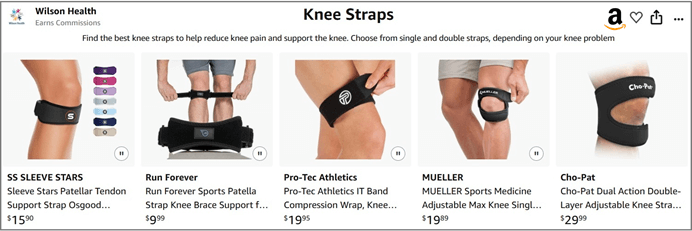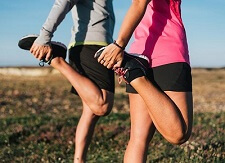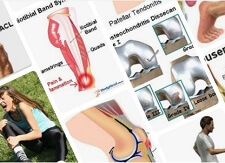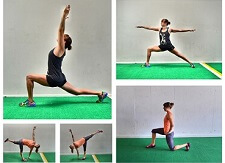- Home
- Common Knee Conditions
- Patellar Tendonitis
Patellar Tendonitis
Written By: Chloe Wilson, BSc(Hons) Physiotherapy
Reviewed by: KPE Medical Review Board
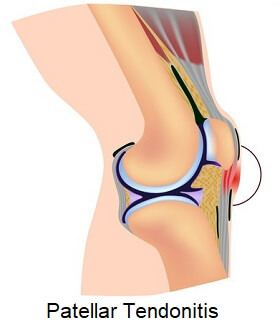
Patellar tendonitis, also known as Jumpers Knee, is caused by damage to the patella tendon. It causes pain and tenderness below the knee and limits activities.
Repetitive sporting activities such as kicking and jumping place a large amount of strain on the tendon resulting in microscopic tears, inflammation and the gradual onset and progression of pain.
Effective treatment is vital to prevent patellar tendinitis from deteriorating until the tendon ruptures completely.
Here, we will take a look at the common causes of patellar tendonitis, typical symptoms, how it progresses and the best treatment options for Jumpers Knee.
What Is Patellar Tendonitis?
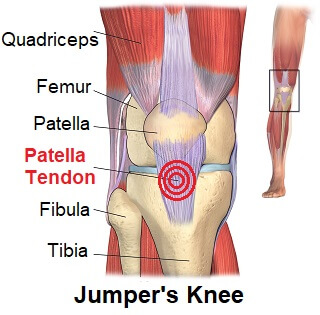
Patellar tendonitis is caused by inflammation and/or degeneration of the tendon that sits just below the kneecap.
The patellar tendon is a long, thick cord-like structure that connects the quadriceps muscles to the tibia, the shin bone via the kneecap.
It is approximately 2cm wide and is extremely strong. Its job is to work with the quadricep muscles to straighten the leg and control forces through the lower leg.
If there is repetitive friction or tension through the patellar tendon then small microscopic tears can develop in the tendon which leads to inflammation and gradual degeneration - patellar tendonitis.
These microscopic tears make the tendon less strong and therefore prone to further damage. The tendon may even completely tear with severe patellar tendonitis. The patella tendon is the most common place to develop knee tendonitis and the most common cause of pain below the knee.
What Causes Patellar Tendonitis?
Patellar tendonitis develops when there is repeated excessive force placed on the patella tendon, usually during sports. The greater the force, the more damage is done.
Common causes of patellar tendonitis include:
- Repetitive Jumping: Taking off and landing places a huge force on the tendon approximately ten times body weight. To be able to jump, the quads have to work with the calf muscles to propel the body off the ground and during landing, the quads work have to work again to stabilise the leg
- Repetitive kicking: places a force approximately seven body weight on the tendon
- Muscle Imbalance: Tightness and weakness in the quadricep muscles can place the patellar tendon under more strain making it prone to damage
- Overtraining: training too hard, suddenly increasing your activity levels or are not taking adequate rests between training sessions increase the risk of developing patellar tendonitis
- Bone Spurs: excess lumps of bone can form, known as knee spurs or osteophytes. If they get large enough they can rub against the patellar tendon, increasing the risk of patellar tendonitis.
If someone is doing lots of activity, e.g. sports players, the strain on the patella tendon can become too great and microscopic tears develop in the tendon. This is even more likely if the activity is done on hard surfaces e.g. a basketball court rather than grass
Patellar tendinitis usually comes on gradually over time, rather than being caused by a specific incident. There may not be any pain initially, but as the condition progresses and more tears develop, the knee will get gradually more and more painful.
Symptoms Of Jumpers Knee
The most common symptoms of patellar tendonitis are:
- Pain just below the knee cap with activity e.g. jumping, running, squatting
- Pain with any pressure through the tendon e.g. touch, kneeling
- Aching and stiffness after activity
- Stiffness in the morning
- Thickening of the tendon
The symptoms of jumpers knee tend to get worse over time, increasing in frequency and intensity.
Patellar tendonitis is often misdiagnosed as Runners Knee, Osgood Schlatters or Chondromalacia Patella, but the most defining characteristic of jumpers knee is tenderness when you press on the patella tendon, just below the kneecap.
Stages of Jumpers Knee
Patella tendonitis typically progresses through four stages:
Stage 1: Pain only after activity which doesn’t affect function
Stage 2: Pain with initial activity that disappears as you warm up, but returns after activity. Performance is not usually affected.
Stage 3: Prolonged pain during and after activity with increasing difficulty performing at a satisfactory level
Stage 4: Complete tear of the tendon requiring surgical repair
Inflammation or Degeneration?
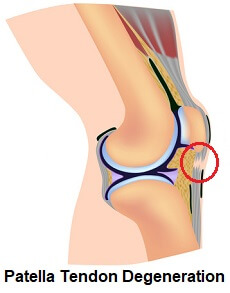
It used to be thought that inflammation was the main cause of Jumpers Knee, hence the name patellar tendonitis (itis = inflammation).
However, recent studies have shown that an inflammatory response is actually very rare.
It is actually more common to have degeneration i.e. wear and tear of the tendon. As a result, health professionals now often refer to it as Patellar Tendonosis (osis means degeneration).
This explains why non-steroidal anti-inflammatories like ibuprofen often have little effect on the symptoms of patella tendonitis and they can actually make things worse by slowing down healing.
The body recovers from the degeneration associated with Jumpers Knee by producing collagen that repairs the tissue damage. However, this is a slow process and it takes approximately three months for sufficient collagen to be both laid down and to mature fully in order to allow the tendon to return to full strength.
Treating Patellar Tendonitis
So how do you treat patellar tendonitis? There are a number of different treatment options for Jumpers Knee which help to reduce the tension on the tendon and improve the strength around the knee.
Patellar tendonitis treatment usually involves a combination of:
1. Relative Rest
Patellar tendonitis is one of those cases where the saying “no pain no gain”
does NOT apply. It is really important to rest completely from any
activity that causes pain to allow the tendon to heal, otherwise it is like picking at a scab. Each time you interrupt the healing processes by overloading the tendon, you cause further injury which increases healing time.
It may take up to 3 months before you can return to sports after suffering from Jumper's Knee.
2. Knee Straps
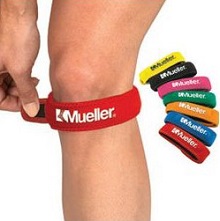
In the early stages of Jumpers Knee, knee straps can work really well to reduce the stress going through the patellar tendon and alleviate symptoms. They reduce the cross sectional area of the tendon and the pressure applied by the strap reduces the force going through the tendon.
Visit the knee strap section to find out more about how they can help with patellar tendonitis, including recommendations based on users feedback, or our Amazon US storefront.
3. Regular Ice
Ice packs applied for 10-15 minutes every couple of hours, before and after activity can help to reduce pain from patellar tendonitis. Visit the Ice Treatment section to find out how to safely and effectively use ice therapy and the ice wrap section for the best ways to apply ice.
4. Knee Stretches
Tightness in the hips, quads and hamstrings increases the risk of developing Jumpers
Knee so it is important to stretch these muscles out. This will not only help the pain and stiffness at the knee, but will also help reduce the chances of the symptoms returning when you start back at your normal activities.
Visit the knee stretches section for simple tests you can do to see if your muscles are tight and find out the best way to stretch out.
5. Strengthening Exercises
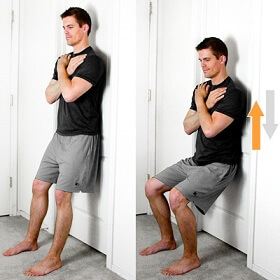
Strengthening exercises are a vital part of patellar tendonitis treatment to ensure that the problem doesn't return in the future.
The best place to start is with quads strengthening exercises to improve the strength, control and endurance of the anterior thigh muscles. These should also include VMO exercises for the small muscles right next to the kneecap.
Weak glutes can affect the position of the knee and lead to increased force going through the patellar tendon, resulting in tendonitis so it really helps to strengthen them. The simplest way to strengthen the glutes is through Clam and Bridging exercises – visit the glutes strengthening section to find out how to do these and loads more.
Eccentric exercises can also be helpful, this is when you strengthen the muscle as it lengthens, rather than the usual approach of strengthening it as it shortens.
6. Knee Surgery
If patellar tendonitis fails to resolve after 6-12 months of rehab,
surgery is performed as a last resort. Surgery involves removing the
degenerative tissue and looks to increase blood flow to the area to
promote healing.
If the patellar tendon ruptures (tears completely), surgery is required to repair the tendon by sewing it back together. After surgery, careful rehabilitation is essential as the tendon will be weak and it usually takes 3-6 months of physical therapy to return to sports.
What Else Could It Be?
There are a number of other conditions which produce symptoms similar to patellar tendonitis, the two most common being:
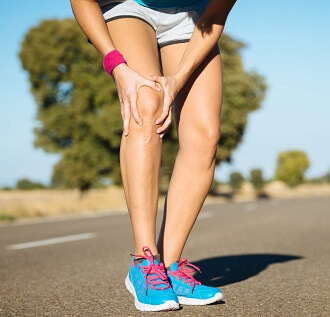
- Runners Knee: a condition where there is a problem with how the kneecap moves - just as likely to affect office workers as runners despite the name!
- Chondromalacia Patella: damage to the cartilage the lines the back of the knee cap
Another condition closely associated with patellar tendonitis is quadriceps tendonitis, which affects the tendon directly above the kneecap. The two conditions often go hand in hand. Alternatively, hamstring tendonitis occurs at the back of the knee.
If this doesn’t seem quite like your pain, visit the Pain Below Knee or Front Knee Pain sections to find out about the most common causes of pain around the front of the knee, including causes, symptoms and treatment options.
Summary
- Patellar tendonitis is a common problem causing pain below the knee
- The patellar tendon is found just below the kneecap connecting the quads muscles to the shin bone
- Repetitive overloading causes irritation, inflammation and degeneration in the patellar tendon
- The most common cause of patellar tendonitis is sports involving repetitive jumping and kicking
- Patellar tendonitis treatment usually involves a combination of rest from aggravating activities, a rehab program of strengthening and stretching exercises, ice, knee straps and medication
- Most cases of jumpers knee will settle within around 3 months with correct patellar tendonitis treatment
Related Articles
Last Updated: September 10th, 2025
Next Review Due: September 10th 2027
